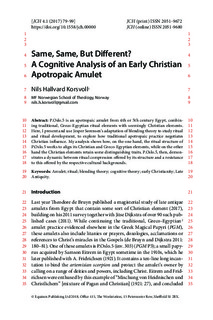| dc.contributor.author | Korsvoll, Nils H. | |
| dc.date.accessioned | 2018-12-17T11:37:50Z | |
| dc.date.available | 2018-12-17T11:37:50Z | |
| dc.date.created | 2018-12-14T10:31:22Z | |
| dc.date.issued | 2017 | |
| dc.identifier.citation | Journal of Cognitive Historiography. 2017, 4 (1), 79-99. | nb_NO |
| dc.identifier.issn | 2051-9672 | |
| dc.identifier.uri | http://hdl.handle.net/11250/2577913 | |
| dc.description.abstract | P.Oslo.5 is an apotropaic amulet from fourth- or fifth century Egypt, combining traditional, Greco-Egyptian ritual elements with seemingly Christian elements. Here, I present and use Jesper Sørensen’s adaptation of blending theory to study ritual and ritual development, to explore how traditional apotropaic practice negotiates Christian influence. My analysis shows how, on the one hand, the ritual structure of P.Oslo.5 works to align its Christian and Greco-Egyptian elements, while on the other hand the Christian elements retain some distinguishing traits. P.Oslo.5, then, demonstrates a dynamic between ritual compression offered by its structure and a resistance to this offered by the respective cultural backgrounds. | nb_NO |
| dc.language.iso | eng | nb_NO |
| dc.publisher | Equinox Publishing | nb_NO |
| dc.title | Same, Same, But Different? A Cognitive Analysis of an Early Christian Apotropaic Amulet | nb_NO |
| dc.type | Journal article | nb_NO |
| dc.type | Peer reviewed | nb_NO |
| dc.description.version | acceptedVersion | nb_NO |
| dc.source.pagenumber | 79-99 | nb_NO |
| dc.source.volume | 4 | nb_NO |
| dc.source.journal | Journal of Cognitive Historiography | nb_NO |
| dc.source.issue | 1 | nb_NO |
| dc.identifier.doi | 10.1558/jch.29772 | |
| dc.identifier.cristin | 1643156 | |
| dc.description.localcode | © 2018. This is the authors’ accepted and refereed manuscript to the article. Locked until 4.12.2020 due to copyright restrictions. | nb_NO |
| cristin.unitcode | 194,67,80,0 | |
| cristin.unitname | Institutt for lærerutdanning | |
| cristin.ispublished | true | |
| cristin.fulltext | postprint | |
| cristin.qualitycode | 0 | |
